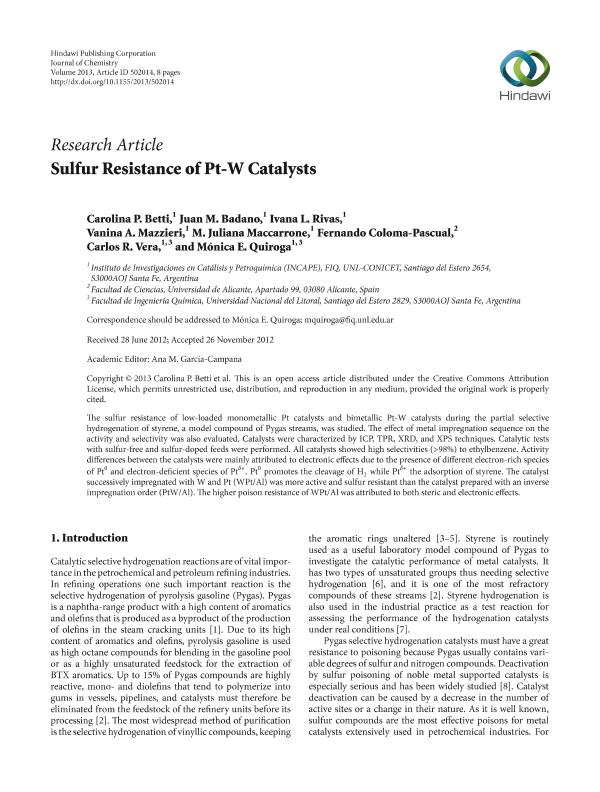Mostrar el registro sencillo del ítem
dc.contributor.author
Betti, Carolina Paola

dc.contributor.author
Badano, Juan Manuel

dc.contributor.author
Rivas, Ivana Lorena

dc.contributor.author
Mazzieri, Vanina Alejandra

dc.contributor.author
Maccarrone, María Juliana

dc.contributor.author
Coloma Pascual, Fernando
dc.contributor.author
Vera, Carlos Roman

dc.contributor.author
Quiroga, Monica Esther

dc.date.available
2020-04-03T17:44:58Z
dc.date.issued
2013-01
dc.identifier.citation
Betti, Carolina Paola; Badano, Juan Manuel; Rivas, Ivana Lorena; Mazzieri, Vanina Alejandra; Maccarrone, María Juliana; et al.; Sulfur Resistance of Pt-W catalyst; Hindawi Publishing Corporation; Journal of Chemistry; 2013; 1-2013; 1-8
dc.identifier.issn
2090-9063
dc.identifier.uri
http://hdl.handle.net/11336/101884
dc.description.abstract
The sulfur resistance of low-loaded monometallic Pt catalysts and bimetallic Pt-W catalysts during the partial selective hydrogenation of styrene, a model compound of PYGAS streams, was studied. The effect of metal impregnation sequence on the activity and selectivity was also evaluated. Catalysts were characterized by ICP, TPR, XRD and XPS techniques. Catalytic tests with sulfur-free and sulfur-doped feeds were performed.All catalysts showed high selectivities (> 98%) to ethylbenzene. Activity differences between the catalysts were mainly attributed to electronic effects due to the presence of different electron-rich species of Pt0, and electron-deficient species of Ptä+. Pt0 promotes the cleavage of H2 while Ptä+ the adsorption of styrene. The catalyst successively impregnated with W and Pt (WPt/Al) was more active and sulfur resistant than the catalyst prepared with an inverse impregnation order (PtW/Al). The higher poison resistance of WPt/Al was attributed to the presence of chloride that inhibits the adsorption of thiophene because of steric and electronic effects. On the other hand, the lower concentration of chloride and a high concentration of Pt0 electron-rich sites (with low BE values) could contribute to the poisoning, as these species would act as electron donor sites, providing available electrons to be bond with the S atom of thiophene. Both effects would promote a strong adsorption of thiophene and thus an enhanced blocking of the catalyst active sites.
dc.format
application/pdf
dc.language.iso
eng
dc.publisher
Hindawi Publishing Corporation
dc.rights
info:eu-repo/semantics/openAccess
dc.rights.uri
https://creativecommons.org/licenses/by-nc-sa/2.5/ar/
dc.subject
BIMETALLIC CATALYSTS
dc.subject
SELECTIVE HYDROGENATION
dc.subject
PLATINUM
dc.subject
SULFUR RESISTANCE
dc.subject
TUNGSTEN
dc.subject.classification
Ingeniería Química

dc.subject.classification
Ingeniería Química

dc.subject.classification
INGENIERÍAS Y TECNOLOGÍAS

dc.title
Sulfur Resistance of Pt-W catalyst
dc.type
info:eu-repo/semantics/article
dc.type
info:ar-repo/semantics/artículo
dc.type
info:eu-repo/semantics/publishedVersion
dc.date.updated
2020-04-02T15:10:28Z
dc.journal.volume
2013
dc.journal.pagination
1-8
dc.journal.pais
India

dc.description.fil
Fil: Betti, Carolina Paola. Consejo Nacional de Investigaciones Científicas y Técnicas. Centro Científico Tecnológico Conicet - Santa Fe. Instituto de Investigaciones en Catálisis y Petroquímica "Ing. José Miguel Parera". Universidad Nacional del Litoral. Instituto de Investigaciones en Catálisis y Petroquímica "Ing. José Miguel Parera"; Argentina
dc.description.fil
Fil: Badano, Juan Manuel. Consejo Nacional de Investigaciones Científicas y Técnicas. Centro Científico Tecnológico Conicet - Santa Fe. Instituto de Investigaciones en Catálisis y Petroquímica "Ing. José Miguel Parera". Universidad Nacional del Litoral. Instituto de Investigaciones en Catálisis y Petroquímica "Ing. José Miguel Parera"; Argentina
dc.description.fil
Fil: Rivas, Ivana Lorena. Consejo Nacional de Investigaciones Científicas y Técnicas. Centro Científico Tecnológico Conicet - Santa Fe. Instituto de Investigaciones en Catálisis y Petroquímica "Ing. José Miguel Parera". Universidad Nacional del Litoral. Instituto de Investigaciones en Catálisis y Petroquímica "Ing. José Miguel Parera"; Argentina
dc.description.fil
Fil: Mazzieri, Vanina Alejandra. Consejo Nacional de Investigaciones Científicas y Técnicas. Centro Científico Tecnológico Conicet - Santa Fe. Instituto de Investigaciones en Catálisis y Petroquímica "Ing. José Miguel Parera". Universidad Nacional del Litoral. Instituto de Investigaciones en Catálisis y Petroquímica "Ing. José Miguel Parera"; Argentina
dc.description.fil
Fil: Maccarrone, María Juliana. Consejo Nacional de Investigaciones Científicas y Técnicas. Centro Científico Tecnológico Conicet - Santa Fe. Instituto de Investigaciones en Catálisis y Petroquímica "Ing. José Miguel Parera". Universidad Nacional del Litoral. Instituto de Investigaciones en Catálisis y Petroquímica "Ing. José Miguel Parera"; Argentina
dc.description.fil
Fil: Coloma Pascual, Fernando. Universidad de Alicante. Facultad de Ciencias; España
dc.description.fil
Fil: Vera, Carlos Roman. Consejo Nacional de Investigaciones Científicas y Técnicas. Centro Científico Tecnológico Conicet - Santa Fe. Instituto de Investigaciones en Catálisis y Petroquímica "Ing. José Miguel Parera". Universidad Nacional del Litoral. Instituto de Investigaciones en Catálisis y Petroquímica "Ing. José Miguel Parera"; Argentina
dc.description.fil
Fil: Quiroga, Monica Esther. Consejo Nacional de Investigaciones Científicas y Técnicas. Centro Científico Tecnológico Conicet - Santa Fe. Instituto de Investigaciones en Catálisis y Petroquímica "Ing. José Miguel Parera". Universidad Nacional del Litoral. Instituto de Investigaciones en Catálisis y Petroquímica "Ing. José Miguel Parera"; Argentina
dc.journal.title
Journal of Chemistry
dc.relation.alternativeid
info:eu-repo/semantics/altIdentifier/url/http://www.hindawi.com/journals/chem/2013/502014/
dc.relation.alternativeid
info:eu-repo/semantics/altIdentifier/doi/http://dx.doi.org/10.1155/2013/502014
Archivos asociados
